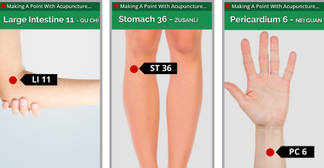✨ What Is  Angelica Sinensis (Dang Gui)?
Angelica Sinensis (Dang Gui)?
Angelica sinensis, commonly known as Dang Gui or “female ginseng,” is one of the most beloved herbs in Traditional Chinese Medicine (TCM). For centuries, practitioners have used it to nourish and invigorate the blood, regulate menstruation, and support overall vitality.
In TCM theory, blood deficiency can manifest as fatigue, dizziness, pale complexion, and irregular or painful periods. Dang Gui helps replenish this deficiency by nourishing the Liver and Heart while gently promoting circulation — a unique dual action of tonifying and moving the blood.
🌸 The Classic Formula: Si Wu Tang (四物汤 – Four-Substance Decoction)
Si Wu Tang is one of the most fundamental herbal prescriptions in women’s health, first recorded in the Song dynasty. It contains four main herbs:
-
Shu Di Huang (Prepared Rehmannia) – deeply nourishes Yin and blood
-
Dang Gui (Angelica sinensis) – tonifies and moves the blood
-
Bai Shao (White Peony Root) – softens the Liver, preserves Yin
-
Chuan Xiong (Szechuan Lovage Rhizome) – invigorates blood circulation and alleviates pain
Together, these herbs create a harmonious formula that both replenishes and circulates blood, preventing stagnation while restoring balance.
💁♀️ Key Functions & Traditional Indications
| Function | Traditional Purpose | Common Clinical Uses |
|---|---|---|
| Tonify Blood | Replenishes vital essence and improves complexion | Anemia-like fatigue, dizziness, postpartum weakness |
| Regulate Menstruation | Harmonizes Liver and reproductive system | Irregular cycles, scanty or delayed menses |
| Invigorate Blood | Promotes smooth circulation and dispels stagnation | Dysmenorrhea (painful periods), blood stasis patterns |
| Support Postpartum Recovery | Rebuilds blood and energy after childbirth | Post-delivery fatigue, pale complexion |
| Nourish Skin & Hair | Enhances glow and vitality | Dry skin, brittle hair, dull complexion |
🔬 What Modern Research Shows
Recent scientific studies have explored the biological mechanisms behind these classical insights:
-
Angelica sinensis polysaccharides demonstrate hematopoietic (blood-forming) and anti-oxidant effects (Wang et al., Phytomedicine, 2019).
-
Ferulic acid, a key active compound, shows vasodilatory and anti-inflammatory benefits (Li et al., Frontiers in Pharmacology, 2021).
-
Si Wu Tang has been observed to regulate hormone balance, reduce uterine spasms, and improve menstrual regularity (Zhou et al., Evidence-Based Complementary and Alternative Medicine, 2020).
-
Clinical observations suggest it supports iron metabolism, beneficial for women with mild anemia (H
-
uang et al., Journal of Ethnopharmacology, 2018).
(Always consult a licensed TCM practitioner before beginning any herbal formula.)
🌿 Integrative Benefits for Modern Wellness
Today, practitioners often use Si Wu Tang as the base formula for many women’s tonics. It may be modified with additional herbs to address specific needs such as:
-
Qi deficiency: add Ren Shen (Ginseng) or Huang Qi (Astragalus)
-
Cold in the uterus: add Rou Gui (Cinnamon bark) or Ai Ye (Mugwort leaf)
-
Severe pain or stagnation: add Yan Hu Suo or Dan Shen for stronger blood-invigorating action
💬 Practical Tips for Patients
-
Maintain a balanced diet rich in leafy greens, beets, and iron-rich foods.
-
Engage in gentle movement (yoga, qigong, walking) to promote blood flow.
-
Consider TCM consultation for personalized herbal guidance — each body pattern differs.
-
Avoid self-prescription of concentrated extracts; classical formulas are best tailored by a practitioner.
🪷 In Summary
Angelica sinensis and Si Wu Tang represent the heart of traditional Chinese gynecology and blood-nourishing therapy. When applied thoughtfully, they help restore vitality, harmonize menstrual cycles, and support holistic wellness — bridging the wisdom of the ancients with the evidence of modern science.
🧧 References
-
Wang Y. et al. (2019). Phytomedicine, 59, 152893. [DOI: 10.1016/j.phymed.2018.152893]
-
Li L. et al. (2021). Frontiers in Pharmacology, 12, 673669. [DOI: 10.3389/fphar.2021.673669]
-
Zhou X. et al. (2020). Evidence-Based Complementary and Alternative Medicine, Article ID 4956789.
-
Huang Y. et al. (2018). Journal of Ethnopharmacology, 221, 35–44.
-
Pharmacopoeia of the People’s Republic of China (2020 ed.).
-
Chen J. & Chen T. (2004). Chinese Medical Herbology and Pharmacology. Art of Medicine Press.
-
Bensky D., Clavell D. (2004). Chinese Herbal Medicine: Materia Medica (3rd ed.). Eastland Press.
-
Ni M. (2013). The Yellow Emperor’s Classic of Medicine: A New Translation. Shambhala Publications.



